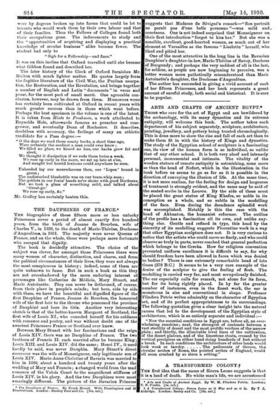THE DAUPHINES OF FRANCE.* Tag biographies of these fifteen more
or less unlucky Princesses cover a period of almost exactly five hundred years, from the birth of Jeanne de Bourbon, wife of Charles V., in 1338, to the death of Marie-Therese, Duchesse d'Angoulinie, in 1851. The majority were never Queens of France, and on the whole, those were perhaps more fortunate who escaped that dignity.
The book is decidedly attractive. The choice of the subject was clever, for amongst these Princesses there were many women of character, distinction, and charm, and from the political circumstances of their lives, they were not always the most conspicuous in history ; indeed, some of them are quite unknown to fame. But in such a book as this they are not overshadowed by the more enduring interest of personages like Catherine de Medicis, Mary Stuart, and Marie Antoinette. They can never be dethroned, of course, from their place in people's minds ; but here, side by side with them, we have the beautiful and dignified figure of the first Dauphine of France, Jeanne de Bourbon, the honoured wife of the first heir to the throne who possessed the province of Dauphine and bore its title. Another very interesting sketch is that of the better-known Margaret of Scotland, the first wife of Louis XL, who consoled herself for his coldness with romance and poetry, and was without doubt one of the sweetest Princesses France or Scotland ever knew.
Between Mary Stuart with her fascinations and the reign of Louis XIV. there was no Dauphine of France. The two brothers of Francis II. each married after he became King; Louis XIII. and Louis XIV. did the same ; Henri IV., it need hardly be said, was never Dauphin. Mary Stuart's direct successor was the wife of Monseigneur, only legitimate son of Louis XIV. Marie-Anne-Christine of Bavaria was married to him in 1080, about a hundred and twenty years after the wedding of Mary and Francis ; a changed world from the mad romance of the Valois Court to the magnificent stiffness of Louis XIV. in his glory. And the two Dauphines were most amazingly different. The picture of the Bavarian Princess
• The Dauphines of France. By Frank Hamel. With Frontispiece and 16 Illustrations. London : Stanley Paul and Co. [168. net.]
suggests that Madame de Sevigne's remark--" Son portrait ne parait pas d'une belle personne "—was mild and, courteous. One is not indeed surprised that Monseigneur on their first introduction "forgot to kiss her." But she was a sensible, excellent, good-hearted woman, as much out of her element at Versailles as the famous " Liselotte " herself, who liked and pitied her.
One of the most attractive in the long line is the Bavarian Dauphine's daughter-in-law, Marie-Therese of Savoy, Duchess of Burgundy; and perhaps the very saddest of all is the last, for seldom, as people are now beginning to perceive, was a better woman more pathetically misunderstood than Mark Antoinette's daughter, the Duchesse d'Angouleme.
The author has succeeded in giving a vivid account of each of her fifteen Princesses, and her book represents a great amount of eareful study, both social and historical. It is sure to be popular.






































 Previous page
Previous page